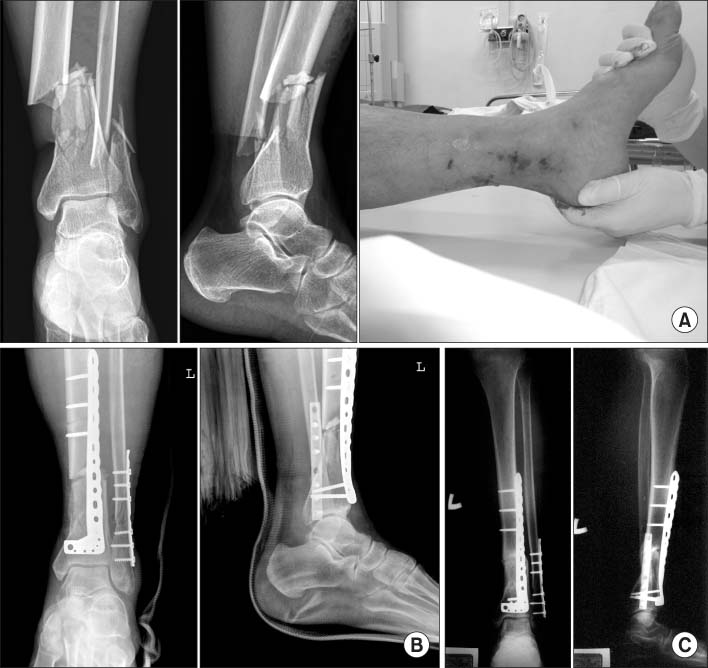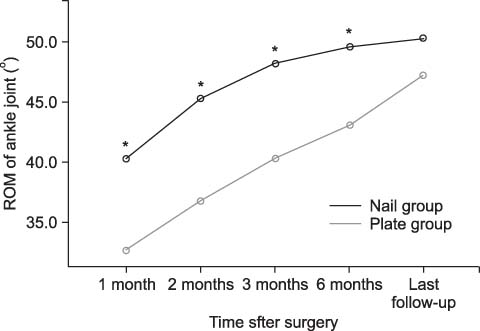J Korean Orthop Assoc.
2014 Aug;49(4):285-293. 10.4055/jkoa.2014.49.4.285.
A Comparison of the Results between Intramedullary Nailing and Minimally Invasive Plate Osteosynthesis in Distal Tibia Fractures
- Affiliations
-
- 1Department of Orthopedic Surgery, Yeungnam University College of Medicine, Daegu, Korea. ossoj@med.yu.ac.kr
- KMID: 2185184
- DOI: http://doi.org/10.4055/jkoa.2014.49.4.285
Abstract
- PURPOSE
The purpose of this study was to compare the results of treatment of distal tibial fractures between intramedullary (IM) nailing and minimally invasive plate osteosynthesis (MIPO).
MATERIALS AND METHODS
Between January 2007 and February 2012, 57 patients (57 cases) were treated for distal tibial fractures. Thirty-two patients (32 cases) were treated with IM nailing (nail group) and the 25 patients (25 feet) were treated with MIPO (plate group). Clinical results were compared using range of motion (ROM) of the ankle joint, American Orthopaedic Foot and Ankle Society (AOFAS) score, and Olerud-Molander score between nail group and plate group. Radiographic results were compared using mean bony union time, coronal and sagittal malunions, and shortening between the groups.
RESULTS
Mean ROM of the ankle joint was significantly larger in nail group until 6 months after surgery; however, it was not different between two groups at the last follow-up. AOFAS score and Olerud-Molander score were not different between two groups at the last follow-up. In the nail group, two malunions more than 5 degrees were observed in coronal and sagittal planes, respectively. One case showed non-union in the plate group, however, bone union was obtained after autogeneous bone graft.
CONCLUSION
Treatment using IM nailing is more advantageous in terms of postoperative rehabilitation than MIPO in distal tibial fractures.
Keyword
MeSH Terms
Figure
Reference
-
1. Dillin L, Slabaugh P. Delayed wound healing, infection, and nonunion following open reduction and internal fixation of tibial plafond fractures. J Trauma. 1986; 26:1116–1119.
Article2. Wyrsch B, McFerran MA, McAndrew M, et al. Operative treatment of fractures of the tibial plafond. A randomized, prospective study. J Bone Joint Surg Am. 1996; 78:1646–1657.
Article3. Jeong H, Yoo JD, Koh YD, Sohn HS. Comparative study of intramedullary nailing and plate for metaphyseal fractures of the distal tibia. J Korean Fract Soc. 2007; 20:154–160.
Article4. Lee GC, Lee JY, Ha SH, Sohn HM, Park YK. Comparative analysis of minimally invasive plate osteosynthesis using periarticular plate and intramedullary nailing in distal tibial metaphyseal fractures. J Korean Fract Soc. 2012; 25:20–25.
Article5. Lee KB, Song SY, Kwon DJ, Lee YB, Rhee NK, Choi JH. A comparison between minimally invasive plate osteosynthesis & interlocking intramedullary nailing in distal tibia fractures. J Korean Fract Soc. 2008; 21:286–291.6. Na HY, Park YJ, Ko SH, Choe WS, Lee YS, Yoon KD. Comparative analysis of interlocking IM nailing and LC-DCP fixation in the treatment of distal tibial fracture. J Korean Soc Fract. 2002; 15:152–158.
Article7. Vallier HA, Le TT, Bedi A. Radiographic and clinical comparisons of distal tibia shaft fractures (4 to 11 cm proximal to the plafond): plating versus intramedullary nailing. J Orthop Trauma. 2008; 22:307–311.
Article8. Park KC, Park YS. Minimally invasive plate osteosynthesis for distal tibial metaphyseal fracture. J Korean Fract Soc. 2005; 18:264–268.
Article9. Martin JS, Marsh JL, Bonar SK, DeCoster TA, Found EM, Brandser EA. Assessment of the AO/ASIF fracture classification for the distal tibia. J Orthop Trauma. 1997; 11:477–483.
Article10. Kitaoka HB, Alexander IJ, Adelaar RS, Nunley JA, Myerson MS, Sanders M. Clinical rating systems for the ankle-hindfoot, midfoot, hallux, and lesser toes. Foot Ankle Int. 1994; 15:349–353.
Article11. Olerud C, Molander H. A scoring scale for symptom evaluation after ankle fracture. Arch Orthop Trauma Surg. 1984; 103:190–194.
Article12. Afsari A, Liporace F, Lindvall E, Infante A Jr, Sagi HC, Haidukewych GJ. Clamp-assisted reduction of high subtrochanteric fractures of the femur. J Bone Joint Surg Am. 2009; 91:1913–1918.
Article13. Teeny SM, Wiss DA. Open reduction and internal fixation of tibial plafond fractures. Variables contributing to poor results and complications. Clin Orthop Relat Res. 1993; 292:108–117.14. Guo JJ, Tang N, Yang HL, Tang TS. A prospective, randomised trial comparing closed intramedullary nailing with percutaneous plating in the treatment of distal metaphyseal fractures of the tibia. J Bone Joint Surg Br. 2010; 92:984–988.
Article15. Bedi A, Le TT, Karunakar MA. Surgical treatment of nonarticular distal tibia fractures. J Am Acad Orthop Surg. 2006; 14:406–416.
Article16. Fan CY, Chiang CC, Chuang TY, Chiu FY, Chen TH. Interlocking nails for displaced metaphyseal fractures of the distal tibia. Injury. 2005; 36:669–674.
Article17. Hahn D, Bradbury N, Hartley R, Radford PJ. Intramedullary nail breakage in distal fractures of the tibia. Injury. 1996; 27:323–327.
Article18. Ajis A, Henriquez H, Myerson M. Postoperative range of motion trends following total ankle arthroplasty. Foot Ankle Int. 2013; 34:645–656.
Article19. Stauffer RN, Chao EY, Brewster RC. Force and motion analysis of the normal, diseased, and prosthetic ankle joint. Clin Orthop Relat Res. 1977; 127:189–196.
Article20. Valderrabano V, Nigg BM, von Tscharner V, Stefanyshyn DJ, Goepfert B, Hintermann B. Gait analysis in ankle osteoarthritis and total ankle replacement. Clin Biomech (Bristol, Avon). 2007; 22:894–904.
Article21. Stamatis ED, Myerson MS. How to avoid specific complications of total ankle replacement. Foot Ankle Clin. 2002; 7:765–789.
Article22. Shon OJ, Park CH. Minimally invasive plate osteosynthesis of distal tibial fractures: a comparison of medial and lateral plating. J Orthop Sci. 2012; 17:562–566.
Article23. Boenisch UW, de Boer PG, Journeaux SF. Unreamed intramedullary tibial nailing--fatigue of locking bolts. Injury. 1996; 27:265–270.
Article24. Janssen KW, Biert J, van Kampen A. Treatment of distal tibial fractures: plate versus nail: a retrospective outcome analysis of matched pairs of patients. Int Orthop. 2007; 31:709–714.25. Yang SW, Tzeng HM, Chou YJ, Teng HP, Liu HH, Wong CY. Treatment of distal tibial metaphyseal fractures: plating versus shortened intramedullary nailing. Injury. 2006; 37:531–535.
Article26. Krettek C, Stephan C, Schandelmaier P, Richter M, Pape HC, Miclau T. The use of Poller screws as blocking screws in stabilising tibial fractures treated with small diameter intramedullary nails. J Bone Joint Surg Br. 1999; 81:963–968.
Article27. Dogra AS, Ruiz AL, Thompson NS, Nolan PC. Dia-metaphyseal distal tibial fractures--treatment with a shortened intramedullary nail: a review of 15 cases. Injury. 2000; 31:799–804.28. Melis GC, Sotgiu F, Lepori M, Guido P. Intramedullary nailing in segmental tibial fractures. J Bone Joint Surg Am. 1981; 63:1310–1318.
Article29. Court-Brown CM, Gustilo T, Shaw AD. Knee pain after intramedullary tibial nailing: its incidence, etiology, and outcome. J Orthop Trauma. 1997; 11:103–105.
Article30. Keating JF, Orfaly R, O'Brien PJ. Knee pain after tibial nailing. J Orthop Trauma. 1997; 11:10–13.
Article
- Full Text Links
- Actions
-
Cited
- CITED
-
- Close
- Share
- Similar articles
-
- Comparison of Results between Minimally Invasive Plate Fixation and Antegrade Intramedullary Nailing of Recon-Type in Low-Energy Injury Distal Femoral Shaft Fractures
- Comparative Analysis of Minimally Invasive Plate Osteosynthesis Using Periarticular Plate and Intramedullary Nailing in Distal Tibial Metaphyseal Fractures
- Comparative Analysis of Minimally Invasive Plate Osteosynthesis and Intramedullary Nailing in the Treatment of the Distal Tibia Fractures
- Intramedullary Nailing versus Minimally Invasive Plate Osteosynthesis for Distal Tibia Shaft Fractures: Retrospective Comparison of Functional and Cosmetic Outcomes
- Comparative Study Using of Treatment with Minimally Invasive Plate Osteosynthesis Using Periarticular Plate and Interlocking Intramedullary Nailing in Distal Tibia Fractures





